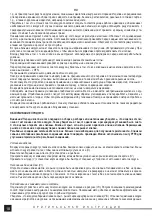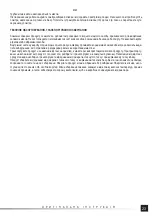
10
O R I G I N A L I N S T R U C T I O N S
EN
Hazards related to repetitive movements
When using a pneumatic tool for work entailing repetitive movements, the operator is exposed to the discomfort of hands, arms,
shoulders, neck, or other parts of the body. When using a pneumatic tool, the operator should take a comfortable posture to en-
sure the feet are correctly positioned and avoid strange or unbalanced postures. The operator should change the posture over a
long time to avoid discomfort and fatigue. If the operator experiences symptoms such as persistent or repeated discomfort, pain,
pulsating pain, tingling, numbness, burning, or sti
ff
ness, they should not ignore them. The operator should inform the employer
and consult a physician.
Hazards connected with accessories
Disconnect the tool from the power supply before replacing the tool to be inserted or accessory. Use accessories and consum-
ables only in the sizes and types recommended by the manufacturer. Do not use cracked or deformed accessories. Check the
condition of the accessories prior to each use.
Hazards connected with the workplace
Slips, stumbles, and falls are the main causes of injury. Beware of slippery surfaces caused by using the tool, as well as tripping
hazards caused by the air system. Proceed with caution in an unfamiliar environment. Hidden hazards may exist, such as electricity
or other utility lines. The pneumatic tool is not intended for use in potentially explosive zones and is not insulated from contact with
electricity. Make sure that there are no electric cables, gas pipes, etc. which could pose a risk in the case of damage with the tool.
Noise hazard
Exposure to high levels of noise can cause permanent and irreversible hearing loss and other problems such as tinnitus (ringing,
buzzing, whistling or buzzing in ears). A risk assessment and the implementation of appropriate control measures for these haz-
ards are necessary. Use hearing protection in accordance with the employer’s instructions and in accordance with hygiene and
safety requirements. The operation and maintenance of the pneumatic tool must be carried out in accordance with the instructions
in the instructions manual in order to avoid an unnecessary increase in noise levels. Selection, maintenance, and replacement of
consumables/inserted tools must be carried out in accordance with the instructions in the manual in order to prevent an unneces-
sary increase in noise levels. If the pneumatic tool has a silencer, always make sure that it is installed correctly when using the tool.
Additional safety instructions for pneumatic tools
The pressurised air can cause serious injuries:
- always disconnect the air supply, release the air pressure from the hose, and disconnect the tool from the air supply when not in
use, before changing accessories, or carrying out repairs;
- never point the air stream at yourself or anyone else.
Hitting with the hose can cause serious injuries. Always check for damaged or loose hoses and connectors. Direct cold air away
from hands. Whenever universal screwed connections (dog connections) are used, safety pins and safety connectors must be
used to prevent damage to the connections between the hoses and between the hose and the tool. Do not exceed the maximum
air pressure speci
fi
ed for the tool. Never carry the tool holding it by the hose.
OPERATING CONDITIONS
The oil dispenser may only be used for the distribution and temporary storage of engine oil, transmission oil, etc. from vehicles
and other machines equipped with a combustion engine. The product is not intended for distribution and temporary storage of
fl
ammable liquids, e.g., petrol, solvents, diesel, alcohol, etc. and corrosive liquids, e.g., brake
fl
uid.
Make sure that the compressed air source generates the correct working pressure and provides the required air
fl
ow. If the supply
air pressure is too high, a pressure regulator with a safety valve must be used. Applying too high a pressure can lead to rupture
of the product components, which can cause serious injuries.
The pneumatic tool must be fed through the
fi
lter and lubricator system. This will ensure that the air is both clean and moistened
with oil. Check the condition of the
fi
lter and lubricator before each use and clean the
fi
lter if necessary or make up for the oil
shortage in the lubricator. This will ensure the correct operation of the tool and extend its service life.
In the case of heavy loads, a recoil force may be generated towards the tool operator. It is necessary to adopt such a posture
during work to be able to counteract these forces e
ff
ectively.
Always make sure that all wrenches and tools used for adjusting are removed before starting work.
Always use protective goggles when adjusting and using the product.
Check the cables and adapters for leaks before each use.
Before connecting to the compressed air source, make sure that all valves and switches are in the “OFF” position.
Do not exceed the maximum supply air pressure.
Never exceed the temperature range of the oil to be distributed. Excessive heat can damage the plastic parts of the product and
cause serious burns.
Do not use this equipment for applications not listed in the manual. Distribution of
fl
uids other than those speci
fi
ed in the instruc-
tions manual may cause injuries and
fi
re, as well as damage to the product.
During oil distribution, the machine that is being
fi
lled with oil must not move.
Summary of Contents for YT-07195
Page 16: ...16 RU YT 07195 0 5 0 1 0 5 150 20 O C 35 101 2 3 119 8 3 7...
Page 17: ...17 RU GEKA...
Page 18: ...18 RU OFF PTFE II III IV V VI VII VIII...
Page 19: ...19 RU VIII IX...
Page 20: ...20 UA YT 07195 M a 0 5 M a 0 1 0 5 150 20 O C 35 dB A 101 2 3 dB A 119 8 3 7...
Page 21: ...21 UA...
Page 22: ...22 UA OFF PTFE II III IV V VI VII VIII VIII...
Page 23: ...23 UA IX...
Page 61: ...61 GR YT 07195 MPa 0 5 MPa 0 1 0 5 l min 150 l 20 O C 35 dB A 101 2 3 dB A 119 8 3 kg 7...
Page 62: ...62 GR...
Page 63: ...63 GR OFF PTFE II III IV V VI VII VIII VIII...
Page 64: ...64 GR IX...











































